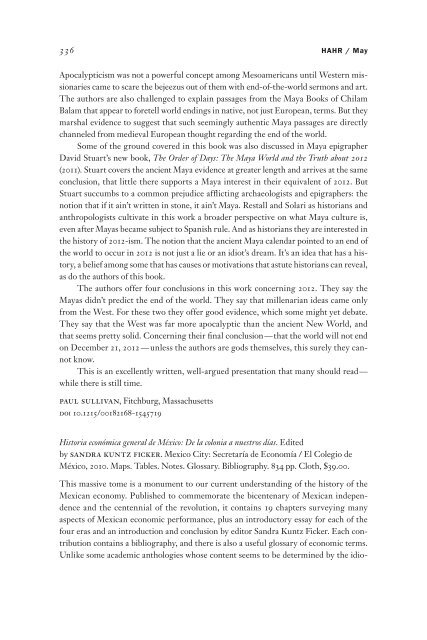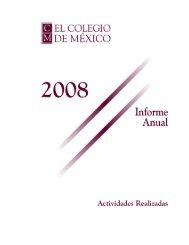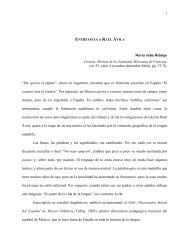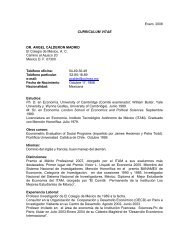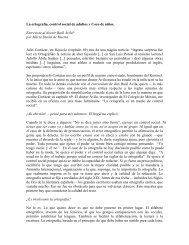sionaries came to scare the bejeezus out of the - El Colegio de México
sionaries came to scare the bejeezus out of the - El Colegio de México
sionaries came to scare the bejeezus out of the - El Colegio de México
Create successful ePaper yourself
Turn your PDF publications into a flip-book with our unique Google optimized e-Paper software.
Book Reviews / General and Sources 337syncratic interests <strong>of</strong> <strong>the</strong> contribu<strong>to</strong>rs, this volume reflects planning and organization <strong>to</strong>provi<strong>de</strong> comprehensive coverage.Had this volume appeared 30 years ago, it would have had much more <strong>to</strong> say ab<strong>out</strong>Marxist mo<strong>de</strong>s <strong>of</strong> production and <strong>de</strong>pen<strong>de</strong>ncy <strong>the</strong>ory. These are now largely missingfrom <strong>the</strong> stage, where new concerns predominate, such as <strong>the</strong> new institutional economics,which holds that institutions shape an economy. Thus, <strong>the</strong> hacienda, forced labor,and <strong>the</strong> pueblo mol<strong>de</strong>d <strong>the</strong> Mexican economy up <strong>to</strong> <strong>the</strong> revolution.Part 1, <strong>the</strong> colonial period <strong>to</strong> 1760, begins with Bernd Hausberger’s overview. Herejects Ruggiero Romano’s view that colonial Mexico’s landholding, labor, and agricultureresembled ancien régime Europe. Hausberger prefers Carlos Sempat Assadourian’sinterpretation emphasizing <strong>the</strong> impact <strong>of</strong> colonial mining on <strong>the</strong> export sec<strong>to</strong>rand domestic economic structures. In o<strong>the</strong>r chapters, Felipe Castro Gutiérrez writesab<strong>out</strong> <strong>the</strong> regional diversity <strong>of</strong> indigenous economy and <strong>the</strong> great <strong>de</strong>mographic collapse.Brígida von Mentz analyzes <strong>the</strong> mining economy; and Manuel Miño Grijalva surveys<strong>the</strong> crafts, commerce, and o<strong>the</strong>r components <strong>of</strong> <strong>the</strong> service sec<strong>to</strong>r. These chapters reflect<strong>the</strong> scarcity <strong>of</strong> hard data on much <strong>of</strong> <strong>the</strong> economy asi<strong>de</strong> from mining and import/exportcommerce. The section lacks a separate chapter on royal taxation and finances.Covering 1760 – 1850, part 2 benefits from <strong>the</strong> better series <strong>of</strong> data generated byBourbon colonialism but must <strong>the</strong>n confront <strong>the</strong> murkier <strong>de</strong>ca<strong>de</strong>s <strong>of</strong> in<strong>de</strong>pen<strong>de</strong>nce an<strong>de</strong>arly nationhood. Carlos Marichal’s survey <strong>de</strong>picts <strong>the</strong> opulent great silver boom, whichhid agrarian crises, wage stagnation, and scarcity <strong>of</strong> monetary s<strong>to</strong>cks <strong>to</strong> carry on domestictra<strong>de</strong>. In<strong>de</strong>pen<strong>de</strong>nce brought few changes, except that taxation <strong>de</strong>clined and capitalinvestment was disrupted. Silver mining stimulated economic growth in <strong>the</strong> late colonialperiod, but social inequality, <strong>the</strong> crown’s drainage <strong>of</strong> specie <strong>out</strong> <strong>of</strong> Mexico, and poor distribution<strong>of</strong> pr<strong>of</strong>its impe<strong>de</strong>d <strong>de</strong>velopment (writes An<strong>to</strong>nio Ibarra). Bourbon fiscal policiesleft Mexico short <strong>of</strong> capital, drained <strong>the</strong> monetary system, and failed <strong>to</strong> promote technologicaland institutional infrastructure; when in<strong>de</strong>pen<strong>de</strong>nce <strong>came</strong>, <strong>the</strong> fiscal systemcollapsed, making it impossible for <strong>the</strong> government <strong>to</strong> promote economic <strong>de</strong>velopment(Luis Jáuregui). Ernest Sánchez Santiró <strong>of</strong>fers <strong>the</strong> revisionist conclusion that following<strong>the</strong> in<strong>de</strong>pen<strong>de</strong>nce crisis <strong>the</strong> Mexican economy recovered between 1835 and 1855 beforestagnating once again.In part 3, Kuntz Ficker’s overview <strong>of</strong> 1856 – 1929 <strong>de</strong>picts a poorly integrated economywhere liberal reforms encouraged entrepreneurship and protected private property.Growth begun during <strong>the</strong> Porfiria<strong>to</strong> did not end with <strong>the</strong> revolution but with <strong>the</strong><strong>de</strong>pression <strong>of</strong> <strong>the</strong> 1930s. Marcello Carmagnani traces <strong>the</strong> recovery <strong>of</strong> public financesand credit. Mexico benefited from foreign tra<strong>de</strong> and investment and was harmed whenthose sec<strong>to</strong>rs were interrupted by <strong>the</strong> revolution (Paolo Riguzzi). General economicgrowth and protectionist policies led <strong>to</strong> some industrialization, but <strong>the</strong> small size <strong>of</strong> <strong>the</strong>domestic market limited <strong>the</strong> potential for domestic manufacturing (Stephen Haber). Theagrarian sec<strong>to</strong>r continued <strong>to</strong> dominate <strong>the</strong> economy until <strong>the</strong> mid- twentieth century,although regional diversity and political radicalization <strong>of</strong> credit prevented its mo<strong>de</strong>rniza-
338 HAHR / Maytion (Daniela Marino and María Cecilia Zuleta). The revolution had a severe but briefeconomic impact. Its most long- lasting result was sociopolitical change that brought realbenefits <strong>to</strong> workers. By 1927, however, <strong>the</strong> economy had stagnated (Alan Knight).During <strong>the</strong> fourth period, 1929 – 2009, Mexican policy makers shifted fromextreme protectionism <strong>to</strong> radical liberalism and from nationalism <strong>to</strong> globalization,with problematic results. In his overview, Enrique Cár<strong>de</strong>nas points <strong>to</strong> <strong>the</strong> policy tensionbetween import substitution and economic liberalism. The former, he notes, producedsustained growth until <strong>the</strong> 1970s, when stagnation set in. Politicians and technocratsopened <strong>the</strong> economy but failed <strong>to</strong> implement completely <strong>the</strong> liberal reforms.Analysis <strong>of</strong> gross domestic product shows that <strong>the</strong> agrarian sec<strong>to</strong>r <strong>de</strong>clined after <strong>the</strong>1940s and that in comparison with Spain, S<strong>out</strong>h Korea, and Brazil, Mexico fell behind(Graciela Márquez). Its low level <strong>of</strong> tax collection impe<strong>de</strong>d Mexico’s ability <strong>to</strong> stimulate<strong>the</strong> economy or improve social welfare through public spending (Faus<strong>to</strong> Hernán<strong>de</strong>zTrillo). Meanwhile, <strong>the</strong> private sec<strong>to</strong>r suffered as public policy swung from nationalismand protectionism <strong>to</strong> globalization and international competition (Gonzalo Castañeda).A technologically mo<strong>de</strong>rn banking system failed <strong>to</strong> penetrate <strong>the</strong> economy sufficiently<strong>to</strong> make credit accessible <strong>to</strong> <strong>the</strong> general population (Gustavo A. <strong>de</strong>l Ángel Mobarak).Corruption and inefficiency plagued <strong>the</strong> energy and transportation sec<strong>to</strong>rs (GuillermoGuajardo So<strong>to</strong>, Fernando Salas, and Daniel Velázquez). Protectionist post- 1930 tra<strong>de</strong>policy helped Mexico industrialize but dis<strong>to</strong>rted <strong>the</strong> allocation <strong>of</strong> resources and un<strong>de</strong>rcutlong- term growth. Liberalization had good tra<strong>de</strong> results but was hampered by incompletereform <strong>of</strong> public policies (J. Ernes<strong>to</strong> López Córdova and Jaime Zabludovsky K.).The 1970s petroleum boom and <strong>de</strong>bt crisis led <strong>to</strong> structural changes but failed <strong>to</strong> sustainlong- term growth (Jaime Ros and Juan Carlos Moreno- Brid). Until 1960 <strong>the</strong> agrariansec<strong>to</strong>r grew, with regional variations, but <strong>the</strong>n stagnated <strong>de</strong>spite statist attempts <strong>to</strong> promoteit (An<strong>to</strong>nio Yúnez Nau<strong>de</strong>).This <strong>out</strong>standing volume reflects <strong>the</strong> maturity <strong>of</strong> his<strong>to</strong>rical studies ab<strong>out</strong> <strong>the</strong>Mexican economy. The individual chapters, nearly all written by Mexican scholars,are not narrowly focused cases <strong>of</strong> microhis<strong>to</strong>ry but broad, thoughtful overviews.Ra<strong>the</strong>r than <strong>de</strong>picting Mexico as a uniform whole, <strong>the</strong>se works skillfully show regionaldiversity. Although some were written by economists, <strong>the</strong> chapters are not la<strong>de</strong>n withjargon and formulae; his<strong>to</strong>rians will find <strong>the</strong>m accessible. In<strong>de</strong>ed this anthology provi<strong>de</strong>sa sophisticated foundation for all who want a nuanced un<strong>de</strong>rstanding <strong>of</strong> Mexicaneconomic his<strong>to</strong>ry.kendall w. brown, Brigham Young Universitydoi 10.1215/00182168-1545728
Copyright <strong>of</strong> Hispanic American His<strong>to</strong>rical Review is <strong>the</strong> property <strong>of</strong> Duke University Press and its contentmay not be copied or emailed <strong>to</strong> multiple sites or posted <strong>to</strong> a listserv with<strong>out</strong> <strong>the</strong> copyright hol<strong>de</strong>r's expresswritten permission. However, users may print, download, or email articles for individual use.


